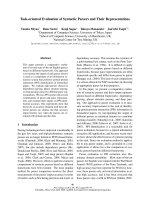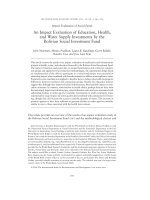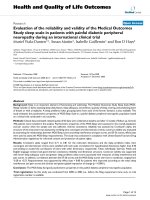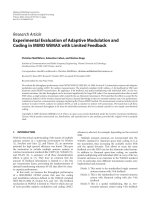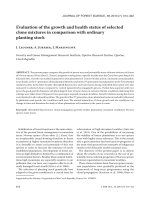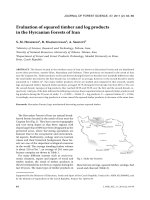Evaluation of histopathological changes and enzyme bioassay during interaction between Verticillium fungicola and Agaricus bisporus - Trường Đại học Công nghiệp Thực phẩm Tp. Hồ Chí Minh
Bạn đang xem bản rút gọn của tài liệu. Xem và tải ngay bản đầy đủ của tài liệu tại đây (335.74 KB, 5 trang )
<span class='text_page_counter'>(1)</span><div class='page_container' data-page=1>
<i><b>Int.J.Curr.Microbiol.App.Sci </b></i><b>(2017)</b><i><b> 6</b></i><b>(11): 4140-4144 </b>
4140
<b>Original Research Article </b>
<b>Evaluation of Histopathological Changes and Enzyme Bioassay during </b>
<b>Interaction between </b>
<i><b>Verticillium fungicola</b></i>
<b> and </b>
<i><b>Agaricus bisporus</b></i>
<b>Jagdeep Singh*, Surjeet Singh, Manoj Kumar, Anil Kumar and Rakesh Kumar </b>
Department of Plant Pathology, College of Agriculture, Chaudhary Charan Singh
Haryana Agricultural University, Hisar-125004, Haryana, India
<i>*Corresponding author </i>
<i><b> </b></i> <i><b> </b></i><b>A B S T R A C T </b>
<i><b> </b></i>
<b>Introduction </b>
The commercial production of edible
mushroom converts different types of
agricultural and household wastes into
nutrition rich food which helps in addressing
the problems of quality food, health and
environmental sustainability. In view of
increasing demand of high quality food with
an increasing world population, mushrooms
will be an important source of proteins that
can replace meat and vegetables and milk
products for a major part (Wani <i>et al., 2010). </i>
About 1.5 million species of fungus are
known (Hawksworth, 1991) and out of these
it has been estimated that 14,000 species
produce fruiting bodies that are desirable to
be considered as mushrooms (Hawksworth,
2001). About 7,000 species of edible
mushrooms are known out of which 200 are
experimentally grown and 10 have been
produced at the industrial scale (Chang and
Miles, 2004). In India, mostly four species of
edible mushrooms <i>viz., </i> <i>Agaricus bisporus </i>
(white button mushroom), <i>Volvariella </i> spp.
(paddy straw mushroom), <i>Pleurotus </i> spp.
(oyster mushroom) and <i>Calocybe indica </i>
(milky mushroom) are commercially
cultivated.
Mushroom cultivation is affected by a large
number of biotic and abiotic factors. Fungi,
<i>International Journal of Current Microbiology and Applied Sciences </i>
<i><b>ISSN: 2319-7706</b></i><b> Volume 6 Number 11 (2017) pp. 4140-4144 </b>
Journal homepage:
<i>Verticillium fungicola </i>var. <i>fungicola </i>(Preuss) is the most important dry bubble
disease causing pathogen of the <i>Agaricus bisporus </i>(Lange) Imbach. Therefore,
present investigation carried out on <i>A. bisporus </i>host and <i>V. fungicola </i>pathogen; by
covering an aspect of interaction, variability and management of <i>Verticillium</i> dry
bubble disease in India. Host and pathogen easily distinguishable at interaction
regions on the basis of hyphal width <i>i.e.</i> ranged from 4.0 to 6.5 µm and 1.5 to 4.5
µm respectively. Pathogen grow inter and interacellularly on host hyphae and
resulting in damaged, coiling and lysis of host mycelia. During enzymatic
bioassay in dual culture on inducing substrate and mushroom extracts,
mycopathogen showed the production of different hydrolytic enzymes <i>i.e.</i>
amylase, cellulose and chitinase but not lipase and pectinase by formation of clear
zonation on substrate.
<b>K e y w o r d s </b>
<i>Verticillium fungicola, </i>
<i>Agaricus bisporus</i>,
Enzyme, Interaction,
Histopathology.
<i><b>Accepted: </b></i>
28 September 2017
<i><b>Available Online: </b></i>
10 November 2017
</div>
<span class='text_page_counter'>(2)</span><div class='page_container' data-page=2>
<i><b>Int.J.Curr.Microbiol.App.Sci </b></i><b>(2017)</b><i><b> 6</b></i><b>(11): 4140-4144 </b>
4141
bacteria, viruses, nematodes, insects and
mites are different biotic factors that damage
the mushroom crop directly or indirectly
(Sharma <i>et al., </i> 2011). Among the various
factors responsible for low production and
productivity of mushroom in our country,
fungal diseases play a major role. The fungal
pathogens, <i>Verticillium fungicola, Mycogone </i>
<i>perniciosa, </i> <i>Trichoderma </i> spp. and
<i>Papulaspora byssina are the predominant </i>
mycopathogens. Amongst these, <i>Verticillium </i>
<i>fungicola </i> var. <i>fungicola </i> (Preuss) is the
important pathogen of the <i>Agaricus bisporus </i>
(Lange) Imbach and annual losses to the
growers are estimated to be 2–4% of total
revenue (Berendsen <i>et al., 2010). The </i>
pathogen induces various symptoms like
bubbles (undifferentiated spherical masses),
bent and/or split stipes (blowout) and spotty
caps. Inoculation of <i>A. bisporus crop with </i>
isolates of <i>V. fungicola </i> var. fungicola of
various degrees of aggressiveness showed that
the more aggressive isolates induced higher
numbers of bubbles (Largeteau and Savoie,
2008). The Verticillium dry bubble is the most
prevalent disease and if left uncontrolled in
the mushroom growing environment; the
disease can wipe out an entire crop in 2–3
weeks (Sharma <i>et al., 2002). Moreover, the </i>
disease may be devastating for years
following the initial infection because spores
are capable of resting in debris and
re-infecting crop year after year (Berendsen <i>et </i>
<i>al., 2010). </i>
<b>Materials and Methods </b>
By dual culture method hyphal interactions
between <i>A. bisporus </i>and <i>V. fungicola were </i>
studied by growing five mm mycelia disk cut
from actively growing colonies of both fungi
and were placed six cm apart on the surface of
2% PDA in Petri plates and 0.2 % PDA on a
clean and sterile glass microscope slide and
incubated both at 25±1˚C for nine days. The
antagonist grew radially and overgrowth of A.
<i>bisporus by V. fungicola </i>began to occur by 5
to 7 days after inoculation. Mycelial samples
from the interaction region in Petri plates
were excised along with agar media and in
case of glass microscope slide the mycelia at
point of interaction directly examined and
each one stained with methylene blue during
examination. These samples were examined
under high power objective of optical
research compound microscope (40X).
Records of the interactions between opposing
colonies including hyphal width, contact or
coiling were made after incubation. After one
week, the slides were examined
microscopically for lysis of <i>A. bisporus </i>
mycelium by <i>V. fungicola. </i> Extracellular
enzymes (viz. amylase, cellulase and
chitinase) bioassays of pathogen during <i>V. </i>
<i>fungicola and A. bisporus interaction as per </i>
methods of Cattelan et al., (1999) and Lima et
<i>al., (1993). Fungal enzymes play an important </i>
role in host infection since they can localize
on host structures to develop infection and
eventually leading to disease. Hence, the
qualitative bioassay was performed to
estimate the presence of extracellular
enzymes <i>i.e. amylase, cellulose, chitinase, </i>
lipase and pectinase during interaction of <i>V. </i>
<i>fungicola and A. bisporus in dual culture. </i>
<b>Results and Discussion </b>
<b>Mode of parasitism under microscope </b>
</div>
<span class='text_page_counter'>(3)</span><div class='page_container' data-page=3>
<i><b>Int.J.Curr.Microbiol.App.Sci </b></i><b>(2017)</b><i><b> 6</b></i><b>(11): 4140-4144 </b>
4142
hyphae of host and coiling and lysis of host
hyphae were also reported after two weeks of
incubation.
During interactions studies the host and
pathogen easily distinguish and at interaction
point host mycelium damaged and pathogen
grow in and on hyphae of host and coiling and
lysis of host hyphae were also reported after
two weeks of incubation. These findings are
in complete agreement with Pieterse (2005)
and Sabharwal et al., (2014) that depicted the
clear difference in hyphal diameter of host
and pathogens and easily distinguishing the
two under interaction studies. Similarly, Dragt
<i>et al., (1996) showed that hyphae of the </i>
mycopathogen coil around the host hyphae
with firm adhesions but intra-hyphal growth
can also be observed in dry bubble pathogen
<i>Verticillium fungicola var. fungicola. </i>
<b>Table.1 </b>Enzymatic bioassay during interaction of <i>Agaricus bisporus </i>and <i>Verticillium fungicola</i>
<b>Sr. </b>
<b>No. </b>
<b>Enzymatic activity *bioassay during host and pathogen interaction </b>
<b>Name of </b>
<b>enzymes </b>
<b>Activity inducer </b>
<b>medium </b>
<i><b>Agaricus </b></i>
<i><b>bisporus </b></i>
<i><b>Verticillium </b></i>
<i><b>fungicola </b></i>
<b>Both </b>
<b>1 </b> Amylase Substrate <b>+ </b> <b>+ </b> <b>+ </b>
Mushroom extract <b>- </b> <b>+ </b> <b>+ </b>
<b>2 </b> Cellulase Substrate <b>+ </b> <b>+ </b> <b>+ </b>
Mushroom extract <b>- </b> <b>+ </b> <b>+ </b>
<b>3 </b> Chitinase Substrate <b>- </b> <b>+ </b> <b>+ </b>
Mushroom extract <b>- </b> <b>+ </b> <b>+ </b>
<b>4 </b> Lipase Substrate <b>- </b> <b>- </b> <b>- </b>
Mushroom extract <b>- </b> <b>- </b> <b>- </b>
<b>5 </b> Pectinase Substrate <b>- </b> <b>- </b> <b>- </b>
Mushroom extract <b>- </b> <b>- </b> <b>- </b>
*Average of three replications, Where + : zone (enzyme activity) present and - : zone (enzyme activity) absent
<b>A- Fungal hyphae</b> <b>B-Hyphal contact</b>
<b>C- Hyphal coiling</b> <b>D- Hyphal lysis</b>
<b>Host</b>
<b>Pathogen</b>
</div>
<span class='text_page_counter'>(4)</span><div class='page_container' data-page=4>
<i><b>Int.J.Curr.Microbiol.App.Sci </b></i><b>(2017)</b><i><b> 6</b></i><b>(11): 4140-4144 </b>
4143
<b>Plate.1 </b>
<b>Extracellular enzymes bioassays </b>
<i>V. fungicola screened for its extracellular </i>
enzymes bioassay (Table-1) like amylase,
cellulose, chitinase, lipase and pectinase
activity by plate assay method during host–
pathogen interaction. The qualitative
assessment of mycopathogen singly as well as
in dual culture on enzymatic activity inducer
medium substrate and mushroom extracts
showed the production of different hydrolytic
enzymes <i>i.e. amylase, cellulose and chitinase </i>
but not lipase and pectinase. <i>V. fungicola </i>
singly as well as in dual culture showed the
clear zonation on substrate and mushroom
extract which are due to enzymatic activity of
amylase, cellulose and chitinase while, rest
one (lipase and pectinase) no any zonation are
reported. The qualitative assessment of
mycopathogen singly as well as in dual
culture on enzymatic activity inducer medium
substrate and mushroom extracts showed the
production of different hydrolytic enzymes
<i>i.e. amylase, cellulose and chitinase but not </i>
lipase and pectinase. Therefore, we
considered that the disintegration of host
hyphae due to enzymatic activity of
mycopathogen. Similarly, Mills <i>et al., (2008) </i>
confirmed that <i>V. fungicola produced a wide </i>
range of hydrolytic enzymes, which play a
critical role in the infection process. On the
other hand, Trigiano and Fergus, (1979)
reported that <i>V. fungicola is able to produce </i>
extracellular enzymes such as an amylase,
lipase and cellulose.
During interactions studies the host and
pathogen easily distinguish and at interaction
point host mycelium damaged and pathogen
grow in and on hyphae of host and coiling and
lysis of host hyphae were also reported after
two weeks of incubation. V. fungicola in dual
culture showed the clear zonation on substrate
and mushroom extract which are due to
enzymatic activity of amylase, cellulose and
chitinase.
</div>
<span class='text_page_counter'>(5)</span><div class='page_container' data-page=5>
<i><b>Int.J.Curr.Microbiol.App.Sci </b></i><b>(2017)</b><i><b> 6</b></i><b>(11): 4140-4144 </b>
4144
<b>References </b>
Berendsen, R.L., Baars, J.P.P., Kalkhove,
S.I.C., Lugones, L.G., Wosten, H.A.B.
and Bakker, P.A.H.M. (2010).
<i>Verticillium fungicola: causal agent of dry </i>
bubble disease in white-button
mushroom. Mol. Pl. Pathol., 11: 585–595
Cattelan, A.J., Hartel, P.G. and Fuhrmann, J.J.
(1999). Bacterial composition in the
rhizosphere of nodulating and
non-nodulating soybean. <i>Soil Sci., 62: </i>
1549-1555.
Chang, S.T. and Miles, P.G. (2004).
<i>Mushrooms: Cultivation, Nutritional </i>
<i>Value, </i> <i>Medicinal </i> <i>effect </i> <i>and </i>
<i>Environmental Impact </i> (2nd edition).
Boca Raton, CRC press. pp 6.
Dragt, J.W., Geels, F.P., De Bruijn, W.C. and
Van Griensven, L.J.L.D. (1996).
Intracellular infection of the cultivated
mushroom <i>Agaricus bisporus by the </i>
mycoparasite <i>Verticillium. Mycol. Res., </i>
100: 1082-1086.
Hawksworth, D.L. (1991). The fungal
dimension of biodiversity: magnitude,
significance and conservation. <i>Mycol. </i>
<i>Res., 95: 641-655. </i>
Hawksworth, D.L. (2001). Mushrooms: the
extent of the unexplored potential. <i>Int. </i>
<i>J. Med. Mush., 3: 333-337. </i>
Largeteau, M.L. and Savoie, J.M. (2008).
Effect of the fungal pathogen
<i>Verticillium </i> <i>fungicola </i> on fruiting
initiation of its host, Agaricus bisporus.
<i>Mycol. Res. 112: 825-828. </i>
Lima, E.O., Gompertz, O.F., Giesbrecht,
A.M. and Paulo, M.Q. (1993). <i>In vitro </i>
antifungal activity of essential oils
obtained from officinal plants against
dermatophytes. Mycos., 36: 333-336.
Mills, P., Thomas, J., Sergeant, M., Costa, A.,
Collopy, P., Bailey, A., Foster, G. and
Challen, M. (2008). Interaction between
<i>Agaricus bisporus and the Pathogen </i>
<i>Verticillium fungicola. In: Stress un </i>
Yeasts and Filamentous Fungi. Avery
S.V., Stratford M. and Van West P.
(Eds.). pp. 1-18. The British Mycology
Society.
Pieterse, Z. (2005). <i>Mycogone perniciosa, a </i>
pathogen of <i>Agaricus bisporus. M.Sc. </i>
thesis, University of Pretoria, pp. 1-38.
Sabharwal, A. and Kapoor, S. (2014). In vitro
effect of essential oils on mushroom
pathogen Mycogone perniciosa causal
agent of Wet Bubble Disease of White
Button Mushroom. <i>Indian J. Appli. </i>
<i>Res., 4: 482-484 </i>
Sharma, S.R., Satish, K., and Sharma, V.P.
(2002). Diseases and Competitor
Moulds of Mushrooms and their
Management. J. Early Repub., 22:
509-516.
Sharma, V.P., Kumar, S., Kamal, S. and
Singh, S.K. (2011). Etiology and
molecular characterization of wet
bubble disease causing fungus
(Hypomysis perniciosus) in <i>Agaricus </i>
<i>bisporus. Mush. Res. 20 (1): 21-25. </i>
Trigiano, R.N. and Fergus, C.L. (1979).
Extracellular enzymes of some fungi
associated with mushroom culture.
<i>Mycologia, 71: 908-917. </i>
Wani, B.A., Bodha, R.H. and Wani, A.H.
(2010). Nutritional and medicinal
importance of mushrooms. <i>J. Med. Pl. </i>
<i>Res., 4: 2598-2604. </i>
<b>How to cite this article: </b>
</div>
<!--links-->
Evaluation of the Effects and the Programming of ‘Water Conservation Plan’ (WCP) for Total Water Resources Management in Tokyo
- 19
- 593
- 0

